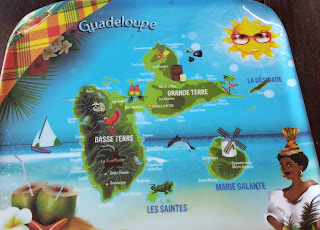But unlike the main island, Marie-Galante never developed urban centers. It is still very pastoral, with small Creole-style towns. Like most islands in the Caribbean, Marie-Galante was once a big rum producer, and slaves were brought in from Africa to produce the rum. Of course, the U.S. has our own shameful history of slavery, but what is different on Marie-Galante is that there are remnants of that history all over the countryside, literally towering over the people as they go about their daily lives.
These abandoned sugar mills from the days of slave plantations are all over the island. According to Wikipedia there are 72 of them on the island. 72 reminders to the current citizens that their ancestors were brought here against their will and forced to work as slaves or that their ancestors had owned those slaves. I grew up in Iowa and now live in Kansas. I have toured a former plantation or two while on vacation. But it was such a strange experience to drive around this beautiful island (I'll show you those photos in my next post) and see constant reminders of the history of slavery. They cannot run from it or pretend it didn't happen. In fact, the windmill/sugar mill is the symbol of the island (see it on the trivet above?)!
We toured one of those former sugar/rum plantations where once over 300 slaves labored. It is called Habitation Murat, and the director of this museum happened to be the same Hubert we met the previous day (I posted about Sunday dinner with his family.) He took us up to the second floor of the museum, the former master's house, so that we could get a view of the grounds and the ocean in the distance.
The final paragraph on the top sign says: "May the sites on this slave route enable us to surpass this crime against humanity, to finally live with our history and no longer be haunted by it."
It seems to me that this is a much more honest approach to facing the sins of our past. Maybe driving by the reminders every day helps everyone confront the past and build a new future. My time on Marie-Galante indicated to me that the descendants of former slaves and former slave-owners are making a way forward together.









No comments:
Post a Comment